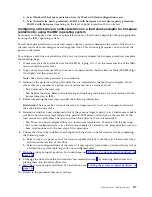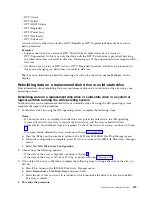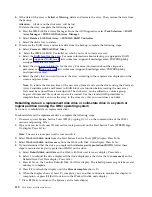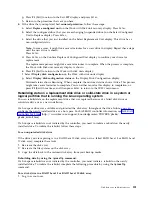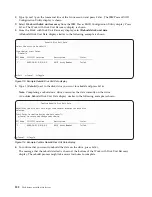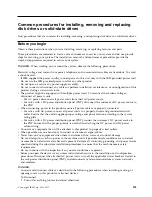
Table 5. Solid-state drive rules for the ESLS storage enclosure.
Storage enclosure
Mixing rules
ESLS storage enclosure (IBM
EXP24SX SAS Storage
Enclosure)
v
A maximum of 24 drives are supported in this enclosure.
v
The EXP24SX can be configured as one set of 24 bays (mode 1), two sets of 12
bays (mode 2), or four sets of 6 bays (mode 4).
v
The EXP24SX serial-attached SCSI (SAS) ports are attached to SAS controllers,
which can be a SAS Peripheral Component Interconnect-X (PCI-X) adapter, PCI
Express (PCIe) adapter, PCI Express Gen2 (PCIE2), PCI Express Gen3 (PCIe3)
adapter or a pair of adapters.
v
The EXP24S can also be attached to a pair of internal SAS controllers (FC EJ0U)
in a system with an external SAS port.
v
The mixing of the SSDs and HDDs is as follows:
– SSDs and HDDs cannot be mixed when configured in mode 1.
– SSDs and HDDs can be mixed when configured in mode 2: one disk partition
can be SSDs and the other disk partition can be HDDs, but you cannot mix
within a disk partition.
– SSDs and HDDs can be mixed when configured in mode 4 depending on the
adapter support. Each disk partition can be either SSDs or HDDs, but cannot
mix within a disk partition.
Mainstream solid-state drives
Learn about the differences between enterprise solid-state drives (SSDs) and mainstream SSDs (previously
called read intensive SSDs).
Traditionally, enterprise SSDs are built on high-endurance multi-level cell (MLC) flash and can handle up
to 10 drive writes per day. These SSDs are referred to as enterprise SSDs in this document (previously
called eMLC). Now, because of software advances and industry demands, less write intensive SSDs can
be used with applications where write operations are less frequent. IBM offers several 4K mainstream
SSDs, including feature codes (FCs) ES8Y, ES8Z, ES96, ES97, ESE7, ESE8, ES83, ES84, ES92, ES93, ESE1,
and ESE2.
Differences between mainstream and enterprise SSDs
Mainstream SSDs are less expensive to use, but also have lower endurance and random write
performance.
Lower endurance for mainstream drives
The NAND flash used in mainstream drives tend to be of lower endurance than the NAND flash used in
SSDs that are targeted for the more write intensive workloads. Therefore, the number of write operations
to a mainstream drive is limited (typically, one drive write per day (DWPD) versus 10 DWPD on an
enterprise drive).
A drive write per day writes the entire capacity of the drive in 24 hours. For example, a DWPD for a 387
GB drive writes 387 GB of data on the drive in 24 hours. You can write more data in a day, but the
DWPD is the average usage rate by which the life span of the drive is calculated. Since many
applications only require about 1 DWPD, these are the most commonly used drives in the industry and
thus used for mainstream applications. Only applications that require high endurance or the highest
random write performance need enterprise drives.
Lower over-provisioning for mainstream drives
108
Disk drives or solid-state drives
Summary of Contents for Power System 5148-21L
Page 2: ......
Page 18: ...xvi Disk drives or solid state drives ...
Page 202: ...184 Disk drives or solid state drives ...
Page 203: ......
Page 204: ...IBM ...
























